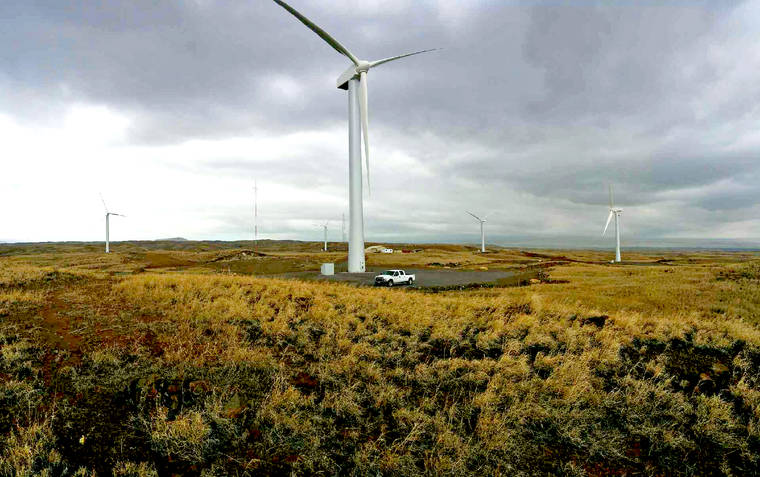KAILUA-KONA — Lalamilo Wind Company in April filed an administrative complaint with the Hawaii County Department of Water Supply in what could prove a predecessor to a multi-million dollar lawsuit.
The complaint claims DWS is guilty of breach of contract, breach of covenant of good faith and fair dealing, misrepresentation and promissory estoppel. The claims stem primarily from LWC’s view that the department has failed to fulfill wind energy purchasing obligations as outlined in a power purchase agreement the entities entered into in 2013.
LWC, formed by Site Constructors, Inc., is seeking remedies to the tune of a little over $1.1 million in total damages for the time period of September 2017 through January, with that number set to rise with each passing month until the parties are able to reach resolution. Also, LWC would likely require going forward that DWS honor the purchasing terms of the agreement as LWC has interpreted them.
“My clients remain ready, willing and able to continue to look for solutions and to engage in good faith negotiations to resolve this claim by Agreement,” wrote Blake Bushnell, of Bushnell Law Group, the author of the complaint. “My clients also agree to participate in mediation if the County feels that process might facilitate a negotiated resolution.”
LWC served DWS with the complaint a little more than seven months after a decision by the Hawaii County Water Board, which ruled the contract language stipulates the department buy only as much wind energy as it can, when it can.
It is LWC’s position that the contract stipulates DWS purchase at least 8,000 megawatt hours (Mwh) annually to keep the energy project financially viable. Such purchasing equates to roughly $180,000 monthly.
Richard Hardin, member/manager at LWC, offered no comment on the complaint, to which DWS has 90 days to respond before other legal options become available. The 90-day window expires in early July. To this point, DWS has not responded to the complaint.
In previous interviews with West Hawaii Today, Hardin tagged the cost of the Lalamilo Wind Farm at roughly $15 million. Any lawsuit seeking what LWC would consider full restitution would begin at $15 million and rise with damages from there.
Any such lawsuit would likely name DWS the primary defendant. However, given the department’s status as only a semi-autonomous organization, Hawaii County could also be named as a defendant, thereby incurring legal costs and potential financial liability totaling millions of dollars.
While Hardin chose not to speak to the company’s future plans regarding legal recourse, he’s been on record in the past saying LWC will seek remedies if DWS doesn’t honor the company’s interpretation of the power purchase agreement.
“From this point on, we’re either going to negotiate something promptly, or we’re going to have to file litigation,” Hardin said in August following the Water Board’s decision.
Background
At the heart of the dispute are figures noted in the agreement outlining the amount of wind energy DWS projected to use on average each year, as well as a minimum amount LWC says the department is mandated to purchase to keep the wind farm viable.
LWC won a county bid in 2013 to build wind turbines that would exclusively supply eight deep wells at the DWS Lalamilo-Parker Well Sites in South Kohala — wells that service Hawaii Island’s major resorts on the Kohala Coast and account for 25 percent of DWS energy consumption.
The plans for a wind farm were part of a county push toward renewable energy goals as the department is Hawaii Electric Company’s largest customer. The wells utilize wind power when it’s both available and DWS has occasion to use it, while relying on HELCO-supplied energy at all other times.
The bid made clear that the wind power produced by whichever entity won it would go to the well sites exclusively. In other words, DWS is LWC’s only customer. Due to the exclusive nature of the relationship, common sense business practices dictate contract language guaranteeing the sole customer would pay for enough energy to make sure the venture at least broke even annually.
Wil Rolston, former Hawaii County energy coordinator who worked on the power purchase agreement and was part of the three-person committee that oversaw the request for proposal, points out in his testimony on behalf of LWC that the contract contained such language in section 4.5.1 of the agreement.
Rolston added the county couldn’t have landed any bidders without a minimum-purchase guarantee.
LWC selling its energy to any other customers would require action by the Hawaii Public Utilities Commission as well as potential grid modifications that together couldn’t materialize for several months or years, rendering a pivot to multiple customers a less than viable solution to address LWC’s immediate financial concerns.
To this point, DWS hasn’t purchased what LWC expected for at least two primary reasons. The first is that at no time since the wind farm has been operational have all eight deep wells been simultaneously functional. For much of that time, only four of the wells were online.
The second issue is logistical. Wind energy isn’t always available, though it is frequently, but if water storage tanks are full then much of the energy produced goes unused. Potential solutions include building more water storage capacity for the wells or stockpiling energy by way of battery storage — both of which would require significant DWS investment.
It is unclear how many of the eight wells are currently pumping or what plans the department has for the site as DWS has chosen to remain mostly silent due to the legal implications surrounding the issue. Keith Okamoto, DWS manager-chief engineer, did offer a brief response to media inquiry Thursday via email.
“… Our position has always been, and continues to be that the Department is abiding by the terms of the power purchase agreement,” Okamoto wrote. “However, due to the recent legal submittal by the contractor’s attorney, we will not be discussing the matter or answering further questions at this time.”






